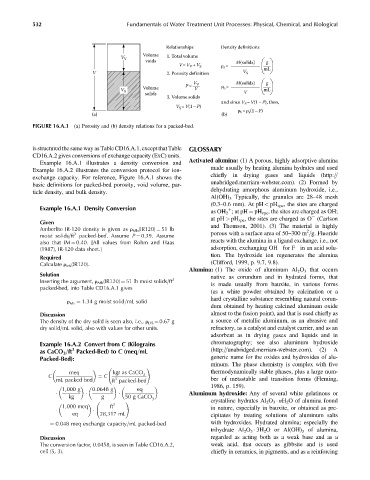Page 577 - Fundamentals of Water Treatment Unit Processes : Physical, Chemical, and Biological
P. 577
532 Fundamentals of Water Treatment Unit Processes: Physical, Chemical, and Biological
Relationships Density definitions
Volume
V V 1. Total volume
voids M(solids) g
V=V V +V S ρ = mL
s
V 2. Porosity definition V S
V V M(solids) g
P =––– ρ =
V S Volume V b mL
solids V
3. Volume solids
and since V =V(1–P), then,
S
V =V(1–P)
S
ρ =ρ (1 –P)
(a) (b) b s
FIGURE 16.A.1 (a) Porosity and (b) density relations for a packed-bed.
is structured the same way as Table CD16.A.1, except that Table GLOSSARY
CD16.A.2 gives conversions of exchange capacity (ExC) units.
Activated alumina: (1) A porous, highly adsorptive alumina
Example 16.A.1 illustrates a density conversion and
made usually by heating alumina hydrates and used
Example 16.A.2 illustrates the conversion protocol for ion-
exchange capacity. For reference, Figure 16.A.1 shows the chiefly in drying gases and liquids (http:==
unabridged.merriam-webster.com). (2) Formed by
basic definitions for packed-bed porosity, void volume, par-
dehydrating amorphous aluminum hydroxide, i.e.,
ticle density, and bulk density.
Al(OH) 3 Typically, the granules are 28–48 mesh
(0.3–0.6 mm). At pH < pH zpc , the sites are charged
Example 16.A.1 Density Conversion
as OH 2 ;atpH ¼ pH zpc , the sites are charged as OH;
þ
at pH > pH zpc , the sites are charged as O (Carlson
Given
and Thomson, 2001). (3) The material is highly
Amberlite IR-120 density is given as r Mb (IR120) ¼ 51 lb 2
3
moist solids=ft packed-bed. Assume P ¼ 0.39. Assume porous with a surface area of 50–300 m =g. Fluoride
also that fM ¼ 0.40. [All values from Rohm and Haas reacts with the alumina in a ligand exchange, i.e., not
(1987), IR-120 data sheet.] adsorption, exchanging OH for F in an acid solu-
tion. The hydroxide ion regenerates the alumina
Required
Calculate r Ms (IR120). (Clifford, 1999, p. 9.7, 9.8).
Alumina: (1) The oxide of aluminum Al 2 O 3 that occurs
Solution native as corundum and in hydrated forms, that
Inserting the argument, r Mb (IR120) ¼ 51 lb moist solids=ft 3 is made usually from bauxite, in various forms
packed-bed, into Table CD16.A.1 gives
(as a white powder obtained by calcination or a
hard crystalline substance resembling natural corun-
r Ms ¼ 1:34 g moist solid=mL solid
dum obtained by heating calcined aluminum oxide
Discussion almost to the fusion point), and that is used chieflyas
The density of the dry solid is seen also, i.e., r DS ¼ 0.67 g a source of metallic aluminum, as an abrasive and
dry solid=mL solid, also with values for other units. refractory, as a catalyst and catalyst carrier, and as an
adsorbent as in drying gases and liquids and in
Example 16.A.2 Convert from C (Kilograins chromatography; see also aluminum hydroxide
3
as CaCO 3 =ft Packed-Bed) to C (meq=mL (http:==unabridged.merriam-webster.com). (2) A
Packed-Bed): generic name for the oxides and hydroxides of alu-
minum. The phase chemistry is complex with five
!
meq kgr as CaCO thermodynamically stable phases, plus a large num-
C ¼ C 3 3
mL packed bed ft packed-bed ber of metastable and transition forms (Fleming,
1986, p. 159).
1,000 g 0:0648 g eq
Aluminum hydroxide: Any of several white gelatinous or
kg g 50 g CaCO 3
! crystalline hydrates Al 2 O 3 nH 2 O of alumina found
3
1,000 meq ft in nature, especially in bauxite, or obtained as pre-
eq 28,317 mL cipitates by treating solutions of aluminum salts
¼ 0:048 meq exchange capacity=mL packed-bed with hydroxides. Hydrated alumina; especially the
trihydrate Al 2 O 3 3H 2 O or Al(OH) 3 of alumina,
Discussion regarded as acting both as a weak base and as a
The conversion factor, 0.0458, is seen in Table CD16.A.2, weak acid, that occurs as gibbsite and is used
cell (5, 3). chiefly in ceramics, in pigments, and as a reinforcing

